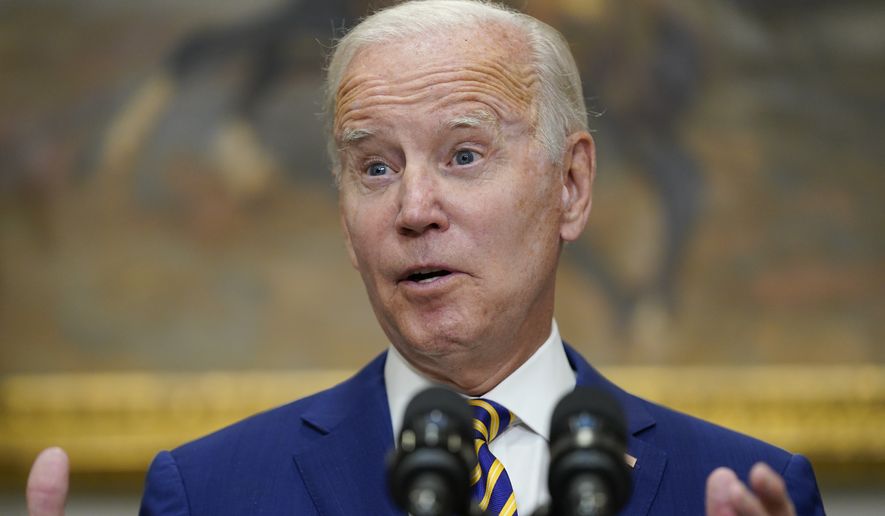President Biden’s student debt forgiveness plan will cost taxpayers $400 billion, according to a Congressional Budget Office estimate released Monday.
The CBO also estimates that the pause on federal student loan payments through December, which Mr. Biden announced last month along with the debt write-off, will cost an additional $20 billion.
The $420 total figure, which is in line with outside estimates, is one more data point worrying budget hawks that Mr. Biden’s debt cancellation plan will further inflame inflation and wipe out his administration’s progress on reducing the deficit.
“CBO’s new estimate confirms the outrageous cost of the White House plan to cancel large amounts of student debt, by executive order, to nearly all borrowers almost regardless of need,” said Maya MacGuineas, the president of the non-partisan Committee for a Responsible Federal Budget.
Mr. Biden unveiled his long-awaited plan last month, which includes canceling $10,000 in student debt for borrowers who earn less than $125,000 per year and $20,000 in debt for those who received Pell Grants.
Mr. Biden‘s plan calls for lowering monthly payments on outstanding undergraduate loans from 10% to 5% of discretionary income and forgives loan balances after 10 years of payments, instead of 20 years for original loan balances of $12,000 or less.
SEE ALSO: Psaki says Dems ‘will lose’ if midterm voters focus on Biden
He also announced one “final” pause on federal student loan repayments brought on by the COVID-19 pandemic through December.
Days after announcing the plan, the White House issued a preliminary cost estimate pegging the cost of the debt write-off at $240 billion over the next ten years, far below independent estimates.
The CRFB estimated Mr. Biden‘s plan would cost the U.S. Treasury between $440 billion and $600 billion and boost inflation by 0.15% to 0.27% over the next year.
A Penn-Wharton Budget Model pegged the cost of just the debt cancellation portion of the plan will cost up to $519 billion. The additional months of loan forbearance tacked on to the plan will cost taxpayers another $16 billion, according to the model. The changes to the income-driven repayment program will cost $70 billion.
That $605 billion figure for all three components of the plan is under static assumptions. But the total could balloon to more than $1 trillion when accounting for potential behavioral changes spurred by changes to the program, according to the analysis.
The CBO estimates that $430 billion in debt will be wiped out under Mr. Biden’s plan, assuming that 90% of income-eligible borrowers will apply for debt cancellation.
SEE ALSO: Biden to host France’s Macron for first state visit
The White House said on Monday that the CBO estimate assumes a higher participation rate than the administration assumed in its preliminary analysis. The CBO analysis also carries beyond the ten-year time horizon modeled by the White House.
In rolling out the plan, Mr. Biden said the widespread relief would reverberate across the entire economy by allowing those saddled by high debt loads to “crawl out from under that mountain of debt, to get on top of their rent and utilities, to finally think about buying a home or starting a family or starting a business.”
As of the end of June, 43 million borrowers held $1.6 trillion in federal student loans, with an average balance of $37,667, according to the administration.
The CBO estimates that 45% of income-eligible borrowers will have their entire outstanding debt canceled. The proposed changes do not reduce the amount of borrowing going forward, but future administrations will likely find themselves under pressure to cancel student loan debt again.
The plan is getting flak from the left and the right and is likely to face significant legal scrutiny. Some liberals said Mr. Biden didn’t do enough. They wanted him to cancel $50,000 or more per borrower. Republicans said the bailout, which is estimated to cost taxpayers as much as $600 billion, would primarily benefit wealthy people who are on a high-earing career path.
They also faulted it for being more out-of-control spending from Democrats. Republicans insist that increased government spending is a key driver behind inflation.
“This might be the most costly executive action in history,” Ms. MacGuineas said. “It’s unacceptable that the president would implement it without offsets and without congressional approval.”
“With inflation at a 40-year high and the national debt approaching record levels, we shouldn’t be adding to deficits – certainly not by executive fiat,” she added.
• Joseph Clark can be reached at jclark@washingtontimes.com.




Please read our comment policy before commenting.